As we have talked about many times, riding in the group is one of the most important skillz you can develop on Zwift. On the road, it’s probably number two to staying upright, but they often go hand-in-hand. We also went over the downside of group riding, the dreaded accordion effect.
 As usual, we started our ride with the 1.5 W/kg warm-up with riders moving around in the group to get a feel for positioning. After about ten minutes, we got into the meat of the class. I moved to the front and directed the group to start moving up from the back, cycling through the front, and drifting to the back again. I maintained the front position to help keep the group under control, but the basic premise was to show how a rider can move up, do a little work, and then recover in the draft of the group. Of course, we did this at a relatively light pace compared to race pace efforts, but the concept is the same. We did a few iterations of this drill at greater intensity to show how much faster a rider can go as part of a group vs solo. This is a key learning point of today’s class.
As usual, we started our ride with the 1.5 W/kg warm-up with riders moving around in the group to get a feel for positioning. After about ten minutes, we got into the meat of the class. I moved to the front and directed the group to start moving up from the back, cycling through the front, and drifting to the back again. I maintained the front position to help keep the group under control, but the basic premise was to show how a rider can move up, do a little work, and then recover in the draft of the group. Of course, we did this at a relatively light pace compared to race pace efforts, but the concept is the same. We did a few iterations of this drill at greater intensity to show how much faster a rider can go as part of a group vs solo. This is a key learning point of today’s class.
In the previous few classes, we covered how a rider can execute a counterattack, one method being after catching a breakaway group. To do so, you have to catch the break. Working in a group without many teammates will require a rider to share some of the load. The easiest way to do this is to keep the group’s pace high, while minimizing the amount of work each rider must do. That’s where the paceline comes into play. In large races with teams with multiple riders, the pace-making is done by the designated individuals who run their own paceline at the front of the peloton. It is sometimes hard to really see because of the large numbers of riders who do not appear to be taking part in the work. In groups smaller than 20 riders, though, the vast majority of the riders will need to share some of the load during a hard chase. The most efficient way to do this is via a paceline.
 In the paceline, riders move forward as other riders finish their time at the front and pull off, or move to the non-wind side and drift to the back. Once at the back, the riders rejoin the line, moving forward to take their next turn. The most important aspect of the paceline is consistency. If a rider surges upon taking over the lead of the line, the fluidity is broken, and other riders have to slow or accelerate to cover gaps. That creates what is known as the accordion effect. The surging and slowing is often not very noticeable at the front of the bunch, but the bigger the line, the more noticeable at the back. The accordion effect can be such that the gaps grow so large that the paceline gets shortened and riders fall off the back.
In the paceline, riders move forward as other riders finish their time at the front and pull off, or move to the non-wind side and drift to the back. Once at the back, the riders rejoin the line, moving forward to take their next turn. The most important aspect of the paceline is consistency. If a rider surges upon taking over the lead of the line, the fluidity is broken, and other riders have to slow or accelerate to cover gaps. That creates what is known as the accordion effect. The surging and slowing is often not very noticeable at the front of the bunch, but the bigger the line, the more noticeable at the back. The accordion effect can be such that the gaps grow so large that the paceline gets shortened and riders fall off the back.
In the second half of the class, I moved around the bunch trying to create gaps, while having the leaders maintain a roughly 2.0 w/kg pace. At one point, the gap got created, and nobody moved across to the main field. Quickly, the gap went from 10 seconds to 30, and we had to chase for a quite a bit of the recovery spin to catch back on. Imagine that at much greater efforts, and you can see how a small bit of surging can destroy the back of the field.
To close out the day, we focused on keeping a very tight group while picking up the speed. Over the remaining ten minutes, we gradually increased the effort from a 1.5 to a 2.5 w/kg, with riders rotating through the front to share the work and others keeping very tight to prevent the accordion effect. Overall, the group did a great job, and most people were able to stay with the group.
During the next class, we will build on the paceline concept and go back to group work to chase down riders up the road. We have worked on this skill before, but this time, we will do it as a semi-organized group rather than as individuals doing the chasing. It will not be at a very hard pace, but you might get a good sweat going. Until then, RideOn!



